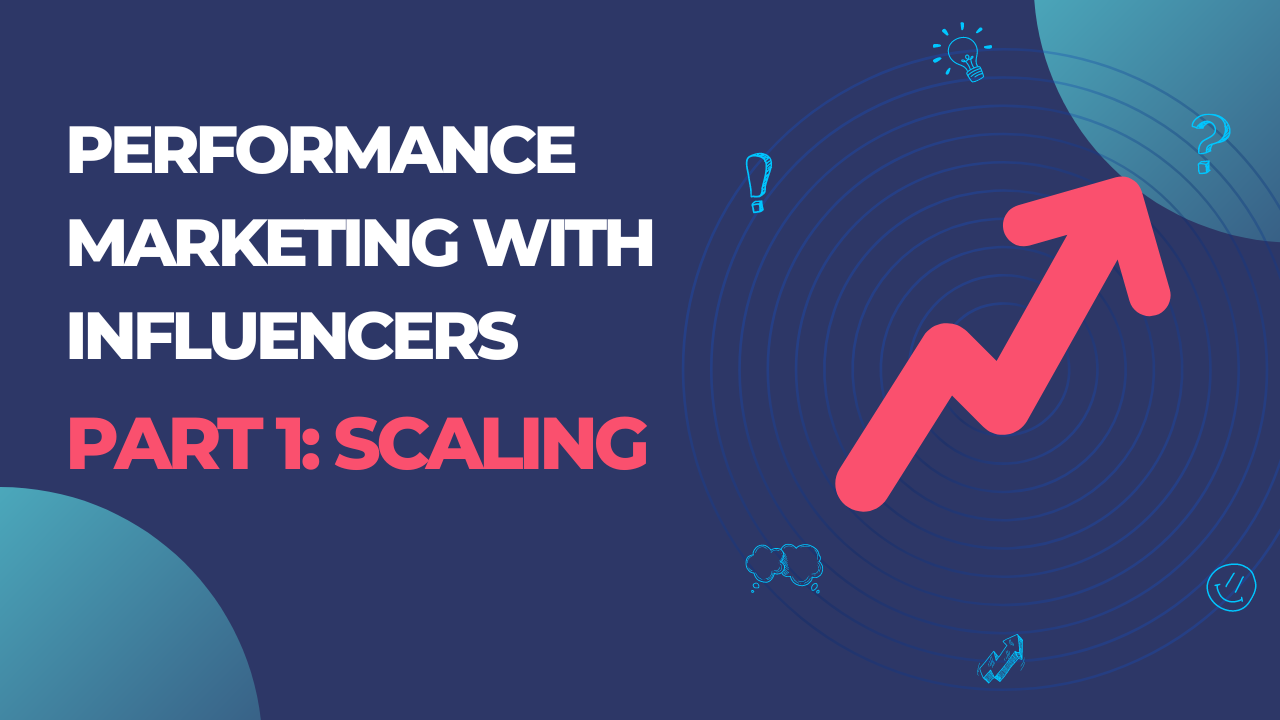In our new article series, we take a look at performance marketing with influencers. In this first part, we talk about the systems needed for scaling the medium effectively, and why many influencer marketing SaaS tools do not actually accomplish this goal that well.
Table of contents
- Why Scale Influencer Marketing?
- Why Do People Think Influencer Marketing Is So Hard to Scale?
- Most SaaS Tools Are a Step in the Right Direction, But Not a Great Leap Forward
- Embracing Full-funnel Automation Can Be Scary, But it is the Only Way
- In Conclusion
- Coming up next
Why Scale Influencer Marketing?
Before going into how influencer marketing should be scaled, we need to understand why it should be done at all.
For a performance marketing channel or medium to be successful, it needs two things: a good return on investment and meaningful scale. One or the other is not enough.
- A channel that has great results but low scale, will eventually get deprioritized because it doesn’t affect the bottom line.
- A channel with massive scale becomes but poor results will get killed or scaled down.
Often, influencer marketing is mistakenly treated as a branding channel only, but it can be one of the biggest, most powerful performance marketing channels when done right.
Performance Marketing with Influencers Makes Sense
Scaling influencer marketing and treating it as a performance marketing medium is worthwhile for a few reasons.
- Creators are not more of the same: Creators complement existing advertising efforts because the content differs from most direct response ads and thus stands out. This means creators can have an extremely good ROI and they’re an excellent source of incremental revenue.
- Creators are perceived differently: While the audience is aware that creator sponsorships are a commercial relationship, they are not perceived to be advertising to the same degree as e.g. social ads, which reduces resistance in many people.
- Creators can be scaled with the right tools: By some estimates, there are more than 50 million people contributing to the creator economy globally. This means as long as you have the right tools and approach, you can keep scaling your efforts.

Photo by Kaleidico on Unsplash
Why Do People Think Influencer Marketing Is So Hard to Scale?
Influencer marketing is the most manual field of online marketing. The biggest reason people think influencers are so hard to scale is also what makes it special: the human element.
Unlike most performance channels where an ad placement is mainly a function of targeting and bids, in influencer marketing each creator is not just a kind of placement but also a “mini-publisher” that you need to negotiate with, weakening your ability to scale.
Most people have the misconception that the only way to scale creators past a certain point is to:
- Hire bigger, more expensive names OR
- Hire additional influencer managers or agencies to make more deals
Hiring Bigger Creators and Increasing Headcount Are Not Silver Bullets
We’re not saying these two approaches can’t work. However, they are ineffective and outdated in most cases for two reasons:
- Relying on bigger creators increases risks. If one big creator fails to deliver results, it can derail the entire campaign. A limited number of creators, even if they are big, also means you have limited capabilities for testing and learning what works.
- Increasing headcount radically increases opportunity cost. An internal team with a large headcount, or hiring multiple agencies, can work for some brands, but for most it will simply result in too much money and time wasted vs. the scale and results achieved.
This means that for most brands, the only realistic road to better, bigger, and consistent results over time is through automation.
However, many advertisers believe that influencer marketing can’t be automated – with the exception of discovery and outreach.
This might be true with conventional influencer SaaS platforms or agencies, but modern creator marketing providers make it possible to unlock highly automated, performance-driven creator marketing.

Photo by Andrea Piacquadio on Pexels.
Most SaaS Tools Are a Step in the Right Direction, But Not a Great Leap Forward
In the past few years, the number of influencer marketing SaaS tools has exploded. While they can be great for discovering influencers and messaging them in bulk, they do not actually solve the problem we discussed.
Most of these tools can be thought of as “creator CRMs” that have two main functionalities:
- Contact and demographic information for creators
- Some messaging capabilities for reaching out to them
So, while these platforms do enable you to reach out to more influencers you think might be a fit, what you end up with is just a ton of work that still needs to be done manually:
- Replying to messages and following up if someone doesn’t respond.
- Contract and price negotiations.
- Making sure the content goes out on time.
- Content reviews.
- Sending each creator unique tracking links for monitoring results.
- Payments that need to be made across the world to people who may have drastically different payment systems and banks.
All of this requires 1-to-1 communication with each creator separately. No matter how efficient an advertiser or an agency may be, they’ll still spend days over multiple weeks getting things ready, and the amount of creators they can manage is limited.
This also means it’s very hard to run creator campaigns month-to-month or as always-on, as the lead times are massive and scaling essentially means paying for headcount or more expensive creators.
SaaS tools won’t help turn influencers into a true performance marketing channel. This is why full-funnel automation and moving to one-to-many communication are the only realistic way in the long run.

Embracing Full-funnel Automation Can Be Scary, But it is the Only Way
Fear of Losing Control Holds People Back
People are hesitant about embracing full-funnel automation in creator marketing. This is understandable, but the fear of losing control is holding them back from truly succeeding with the medium.
Many marketers believe that carefully reviewing each creator before hiring them, even the smallest nano creators, will bring better results. What it actually does is slow you down unnecessarily and makes results dependent on gut feeling over data.
While it does make sense to review and spend more time on strategic collaborations with the biggest names, it really doesn’t make sense to do this for every single creator.
- It slows down the process massively and unnecessarily.
- You’ll eventually run into problems finding new creators because you deem creators that could have worked great “unsuitable”.
- You could handle this much more effectively by basing influencer hiring decisions on data.
Once you use automation-enabled solutions like Matchmade, creators can be hired based on how well they reach your target audience. While every single influencer might not be a perfect fit in all ways with this approach, basing hiring decisions on audience characteristics means they already have engaged viewers who match your audience.
Automation Helps Turn Creators into a Performance Marketing Medium
Once you automate each stage of the influencer marketing process, and go from 1-to-1 communication to one-to-many communication, you’ll be able to reach a bigger scale and work with more creators more frequently.
This opens up possibilities that traditional influencer marketing struggles with – while still taking advantage of the benefits of highly engaged audiences and the unique content format that creators provide.
- A/B testing: the way any performance marketing medium improves over time is testing different elements like ad creative and message or targeting. With a high enough number of creators, you can run similar tests in influencer marketing, allowing you to gradually increase performance and discover what works for your brand.
- More time to focus on essentials: When manual, repetitive tasks are automated, your marketers have time to spend on true value-adding activities. This means more time for things like strategy, negotiating long-term partnerships, and planning new tests. You’ll also most likely reduce the turnover in your marketing team as very few people truly enjoy the repetitive manual work traditional influencer marketing requires.
- Always-on and monthly campaign strategies: When influencer management is automated and you don’t need to spend time on manual back-and-forth, you can run influencer promotions far more frequently than before.
What Can Be Automated?
Almost every single piece of the influencer marketing workflow can be automated with the right platforms like Matchmade, or made better and more efficient by experienced people using the right tools.
Here are a few examples:
- Messaging and follow-ups can be automated for the most part, and a dedicated support person can handle more detailed individual queries in almost real time.
- Contract and price negotiations can be automated and each creator can be offered a straightforward take it or leave it price based on how well they reach your target audience.
- Publishing schedules can be automatically monitored and reminders sent to each creator.
- Creator-specific tracking codes can be created and provided automatically.
- Payments to creators can be made centrally, while the advertiser only needs to pay a single invoice.
In Conclusion
Influencer marketing benefits from highly engaged audiences and unique content formats compared to other forms of online advertising. While doing it in the traditional way can bring results, it doesn’t enable advertisers to take full advantage of the medium.
By automating the entire influencer marketing workflow as much as possible, influencers can be turned into a powerful tool in the performance marketing toolkit that brings both results AND scale.
A few leading brands have already realized this and are seeing amazing results. The question is, will you be one of them?
Coming up next
In the next part of this series, we’ll take a look at what scale truly means with influencers. How big can you go if the sky’s the limit, what kind of pricing models and pacing can you use, and what kind of results can you expect? You can subscribe to our newsletter below to get a notification when the next part is released.
In the meanwhile, if you have any questions or want to discuss how you could scale your influencer marketing efforts and turn creators into a true performance marketing channel, get in touch.




